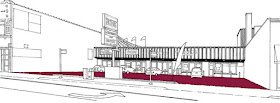Above is a standard strip mall in Rogers Park. These are scattered throughout the neighborhood and are the primary design for auto-oriented businesses along Clark Street. They are often located on corner lots, which provides frontage on two streets and greater visibility. This one is located mid-block, which is unusual.
 |
| The photo is dated 1958 from the UIC Collection "Images of Change." The Sanborn Map is from 1951. |
 |
| Parking and Circulation |
The most important thing about strip malls is the parking lot. Without a parking lot the advantage of the design is lost. In this case almost every square foot has been given over to parking and circulation.
 |
| Primary Sign |
The second most valuable feature of the strip mall is signage. A large sign provides identification for each business on the strip. These signs are generally as big as can be permitted by current sign codes. Signs are designed for cars driving past rather than pedestrians.
 |
| Sign Band |
The sign band is for individual business signs and is designed to easily accommodate mechanical and electrical connections. If the sign band is damaged it can be repaired by replacing the cladding.
 |
| Secondary Signage |
Because the strip mall design creates a break in the street wall it exposes the unfinished walls of the neighboring buildings. Often these are used for signage as well.
Despite the large amount of space dedicated to signage individual tenants still manage to place additional signs and advertising on the site. Here flags have been attached to the sign band, bunting has been strung from the primary sign to the building, and a feather sign has been placed in the planting strip.
 |
| Bollards |
 |
| Planting Strip |
Because the strip mall brings the cars in close to the storefronts additional devices are needed to prevent them from accidentally crashing through. In this case concrete parking stops and metal bollards are used.
More recent strip malls include areas for landscaping. Here a long narrow concrete planter has been located at the front of the lot. Given the size of the strip and its proximity to car exhaust and melting salt nothing can actually grow here. It some point it was paved over. In the winter this is where snow is piled.
Over the years there has been a realization that strip malls are not the most appropriate development for established commercial districts which rely on foot traffic from the adjacent neighborhood. Special zoning overlays can prohibit this type of development, but the community needs to be sophisticated enough to ask for these additional controls. And in many places the damage has already been done.


Larry, do you have any other information about the hospital? Rogers Park/West Ridge Historical Society has a circa 1920 photo that shows it as two stories, but an article in the Chicago Tribune of February 8, 1932, refers to it as six stories. Trying to determine when those four additional stories were added.
ReplyDeleteYou can find another picture of it here, showing a setback penthouse floor from the block to the north. http://collections.carli.illinois.edu/cdm/ref/collection/uic_pic/id/1085
ReplyDeleteIt would be really unusual to add four floors to a 2-story building. More likely there may have been two buildings. In 1937 the hospital was known as the Chicago Clinic of Physical Medicine. That might knock loose some Tribune articles as well. Later it was known as Doctor's General Hospital.
Glenna Eaves with the Rogers Park / West Ridge Historical Society sent me two Chicago Tribune articles about it. The original building (hospital was founded March 10, 1921) was a two-story frame building. It was torn down for the six-story building - construction began May 3, 1926, the dedication was November 11, and it supposedly was to be ready for occupancy January 15, 1927. The article about the dedication says the top floor was "a glass inclosed [sic] sunroom and promenade for convelescents." My dad was taken to this hospital as a little boy after being run over by a car. He definitely remembers it being called Rogers Park Hospital, so your information (thank you!) tells me his accident was before 1937 (he turned 8 in February of that year). The Historical Society's wiki says that Doctors General Hospital apparently closed between 1966 and 1970.
ReplyDeleteAlthough - the circa 1921 picture indicates the frame building must have had a brick facade.
ReplyDeleteThe hospital would make an interesting post. Especially if I could find a good photo showing the entire 6-story building. There are a number of these private neighborhood hospitals remaining, typically established to serve particular ethnic or religious populations. In 2009 Chicago designated the North Chicago Hospital Building on 2551 N. Clark, and this is similar in scale to the former Rogers Park Hospital. https://archive.org/stream/CityOfChicagoLandmarkDesignationReports/NorthChicagoHospitalBuilding#page/n0/mode/2up
ReplyDeleteYou mentioned private neighborhood hospitals and I remember my mom tellling me that my grandmother was friends with a Mrs. Esther Wynekoop (or perhaps Weincoop), whose husband, Dr. Weincoop, owned a small hospital on Sheridan and Glenlake long ago. Dr. Weincoop's nephew, Dr. Wicks became our family physician, starting in the 1950's. Dr. Wicks lived in and had an office in the Edgewater Beach Apartments.
ReplyDeleteI'm not entirely sure about Dr. Weincoop's ownship of the hospital on Sheridan and Glenlake, but wanted to share this information with you.
Interesting. Thank you!
ReplyDeleteThe final days of the building as a hospital were pretty much a disaster as the corporation that owned it was crooked.
ReplyDeleteIt was empty for several years & boarded up until it was torn down.
When it was a hospital, it had a horrible reputation & few people were happy to end up there when the fire dept. took them there.
I'm not sure when Dr. Weincoop was involved with this hospital, or the years it was open. I would like to research the hospital further. Could you share your information source? It sounds awful.
Delete